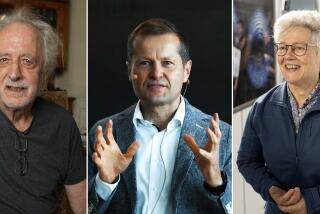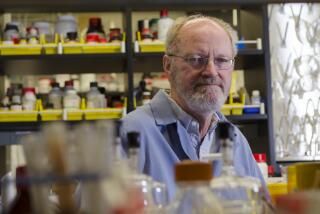Nobel laureate made major atomic finding
Willis e. lamb jr., whose elegant demonstration of a small energy difference between two excited states of the hydrogen atom laid the foundation for the application of quantum theory to electromagnetism, producing the modern field of quantum electrodynamics, has died. He was 94.
Lamb, who was awarded the 1955 Nobel Prize in physics for his work, died May 15 of a gallstone disorder at University Medical Center in Tucson.
“He was a real giant in the field,” said James C. Wyant, dean of the College of Optical Sciences at the University of Arizona, where Lamb spent the last years of his career.
Lamb’s discovery of what came to be known as the “Lamb shift” was “one of the most significant of all postwar experiments,” said fellow Nobel laureate Norman F. Ramsey. Nobel laureate Isidor Rabi said at the time that it was “the most significant advance in 15 years in the knowledge of the atom.”
Twenty years before Lamb’s critical work, English physicist Paul Dirac had used quantum theory to calculate the energy levels possible for the single electron of hydrogen as it absorbs energy from its environment.
He concluded that two of those excited states had exactly the same energy, a finding that seemed unlikely to many researchers. But the first attempts to determine the energy levels gave mixed results and shed little light on the situation.
Lamb had spent much of World War II developing ways to generate microwaves of higher energies and frequencies for use in radar. After the war, he reasoned that the same technology could be used to examine the hydrogen electron’s energy levels.
At Columbia University, he and graduate student R.C. Retherford designed and built a contraption of glass and metal. “You might say the hydrogen atoms went in one end and came out the other end, and in between you did things with them involving microwaves and a magnetic field,” Lamb later said. “The whole thing sat on a table maybe 8 feet long.”
In April 1947 -- “I remember it was on a Saturday,” Lamb said -- the experiment worked. They concluded that the two electron orbits that Dirac had said were identical differed in energy by precisely 1,057.77 megahertz.
Two months later, Lamb was invited to present his work at the historic first Shelter Island Conference on the Foundations of Quantum Physics in New York, the first time since the war that prominent physicists were able to gather and talk without fear of censorship.
Lamb’s finding presented there eventually led theoretical physicists to rethink the application of quantum theory to electromagnetics, leading to many other breakthroughs in the field.
His work also led to another eponymous effect, the Lamb-Bennett dip, which describes how the intensity of a laser drops under certain circumstances. Experimental physicist William Bennett observed the dip experimentally.
Willis Eugene Lamb Jr. was born July 12, 1913, in Los Angeles and educated in public schools here. He received a bachelor’s degree in chemistry from UC Berkeley in 1934, then continued on to graduate school there in physics under the tutelage of J. Robert Oppenheimer, the “father of the atomic bomb.”
In addition to working at Columbia, he was a faculty member at Stanford, Oxford and Yale before joining the University of Arizona in 1974. He formally retired in 2002 but continued working until recently.
Besides the Nobel, Lamb was awarded the National Medal of Science by President Clinton in 2000.
His wife of 57 years, historian Ursula Schaefer, died in 1996. Later that year, he married Israeli physicist Bruria Kaufman, but they divorced, and in January of this year, he married Elsie Watson.
In addition to his wife, he is survived by a brother, Perry, of Maine.
--





